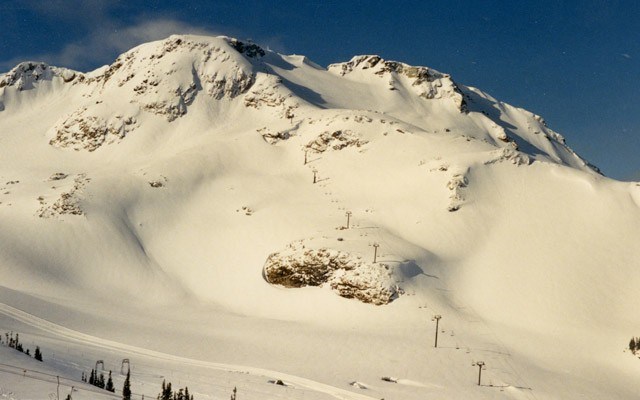From January 1987 to November 1988 I was the alpine caretaker living on top of Whistler Mountain — yes back in those days the mountain actually had a caretaker.
It was a unique time to be working for Whistler Mountain Ski Corporation and a unique job.
There were actually three teams sharing the positions — Gord Harder and myself lived in the alpine (2,100m); our neighbours Laird Brown and Colleen Warner lived at mid-station (1,350m); and Sandy and Molly Boyd lived in the valley (650m).
The position first began in 1978 with the completion of the Alpine Service Building. On the ground floor was the Vehicle Maintenance garage, the Building Maintenance shop, the rescue, first aid, and bomb rooms.
The second floor housed our 500-square-foot suite — Gordy, a mountain carpenter, loved his stairwell commute.
The ski patrol bump room, weather room, and staff lunchroom were all on the second floor as well. The top floor was the Alpine Office — mission control for the mountain where dispatcher Dawn Thompson worked for 23 years. All departmental communications flowed through there.
One of the first jobs to learn was self-evacuation. Right away we were trained in case we were ever stuck on the lift and needed to self-evacuate. It was the oddest thing to push myself out backwards from the chair with my skis on and belay myself down to the ground. The golden rule was never to leave home without a radio — charged — and a lift evacuation rope.
One of our jobs, and to us the most important, was to clear the Red Chair (the top was known as Tower Eighteen) lift line at 5 p.m. every day. It would be dark by the time the restaurant staff finished their shifts, and after the last person was downloaded, we called mid-station to state what chair number they were on. After they offloaded we would shut the lift down.
For the entire ski season I got up every morning at 4:45 a.m., put on all my winter woolies and walked out with a flashlight to the weather plot to read and reset the thermometers on the Stevenson screen, and measure and clean off the stormboard that measured new snow. Then, I went back inside to the weather room, read the wind speed and direction and called in the readings to the snow phone by 5 a.m.
In heavy snowfalls, sometimes getting back and forth to the weather plot was a challenge, thankfully the packer drivers on the graveyard shift generally remembered to make a couple of passes out to the plot so it was an easy stroll.
There were perks too — we had the best opportunities to ski fresh powder, or at the very least perfect corduroy. Sometimes I would ski to the valley as soon as it was light and have a top-to-bottom run all to myself. The valley gondola opened at 7 a.m. to upload staff and I would get in a couple of alpine to valley runs in complete aloneness. I was definitely spoiled — after moving back to the valley in '88 it seemed like a chore to actually get in the truck, and drive two kilometres to the lift and stand in a line up.
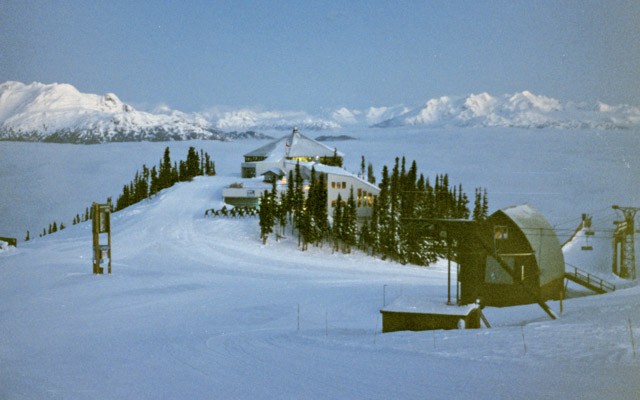
Shortly after moving up to the top of the mountain we got a cat from the SPCA in Squamish. We named her "Schoki" which means "chocolate" in Swiss German. She was only allowed outside after the skiers and staff had gone for the day. She would follow me out to Tower Eighteen and wander around the ramp and then follow me back.
From time to time she became quite the star attraction. She would sit on the windowsill and taunt the avalanche dogs. And on occasion I heard skiers going by on the Little Red Lift calling out in surprise, "There's a cat up here! I think we should tell someone there's a cat up here!"
One of the funniest adventures was when we had to take her to the vet. Gordy put a blanket in his backpack and she nestled in there and we skied to the valley. Part way down her little head peeked out of his backpack; it was quite the sight to see a cat peering out of a knapsack cruising down Gondola Run (later named the Dave Murray Downhill).
Living in a resort, most people work the holidays – including me – so my mom and dad came up to visit on Boxing Day (1987). They brought up a turkey — though it didn't turn out so well, which upset my mom! I blamed all my culinary failures on the elevation, and told her not to worry.
The morning after they arrived the ski patrol was up early to do avalanche control — an everyday occurrence for me — but one that had a profound effect on my dad. He was sitting at our kitchen table when the bombs started to go off. His body started to shake. I'll never forget the look on his face. Dad was a WWII veteran with the Royal Hamilton Light Infantry and those avalanche bombs sent his body into shell shock, and there was nothing I could do for him. All I could do was just hope the bombing would stop soon.
In the summer of 1988 Hollywood came to the alpine. A scene in the movie Shoot to Kill, staring Sidney Poitier and Tom Berenger, was being filmed just past the top of the T-Bars, at the bottom of Little Whistler.
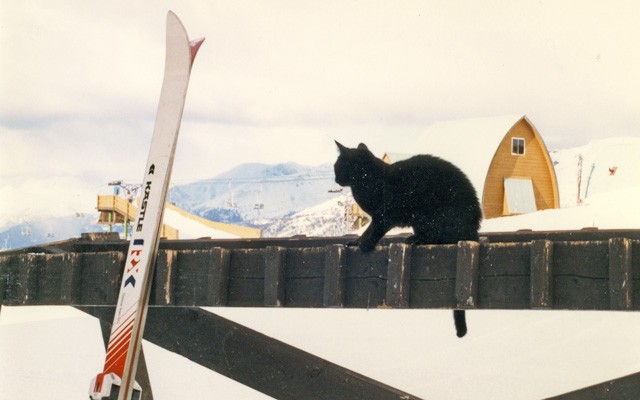
One evening Gordy and I blasted up on the snowmobile to watch them filming. Sidney came over and chatted with us. He was so surprised to learn that someone lived up on the mountain. It was an absolute thrill to meet him. He asked someone to come over and take a photo of the three of us with a Polaroid camera. As I see it, he's such a man of honour and his journey has inspired so many.
Every day, after the skiers and staff were gone, the mountain felt incredibly quiet. We never tired of the alpine glow that flowed over the peaks of the Coastal Mountains. I studied in the evenings, as I was taking correspondent courses and wrote my exams in Squamish. And every now and then, Andrew "Hawk" Russell, electrician, dropped us off Miami Vice recordings!
On occasion friends came up for fondue parties. One full moon we all ended up playing hockey on the skating rink between Pika's Restaurant and the Service Building.
Laird initiated the rink idea and worked hard to get it built. That night Stu Archer was in goal, and the rest of us took shots on him while some twirled around and recalled past figure-skating days. Shortly after, we clicked into our skis and formed two teams: Team Good and Team Bad. We raced down Upper Whiskey Jack under the moonlight while two snowmobiles would take us back up to the top of the run and we'd race all over again.
One snowmobile rolled, the flag broke off, the windscreen cracked, but we kept on skiing. The following morning when Gordy told the vehicle maintenance manager all he asked was, "Anyone hurt?" We all knew if the powers-that-be found out we'd probably be fired. We all worked for the mountain and knew the chance we were taking.
The finale was when we returned to the building and re-arranged one of the mountain manager's offices. We switched everything to the opposite; we moved his desk to the opposite wall, moved the photos, his drawers, and his desktop, everything to the opposite side. The next morning we expected a knock on the door and a termination notice. Nothing happened. Years later I asked that mountain manager why he never said anything, he could have raised quite a fuss, and his answer, "I kind of liked the office that way!"
On occasion Gordy would be called out on a night search for missing skiers. He would jump on the snowmobile and check out a designated area. One particular night a skier was last seen going into the Khyber Pass (out of bounds). Several patrollers and Gordy were going to have to ski down from the peak, and through the trees, that night searching for him. Then, just as one of the packer drivers was set to run the Peak Chair, and just as they were about to load, we learned that the skier had been found – in a bar!
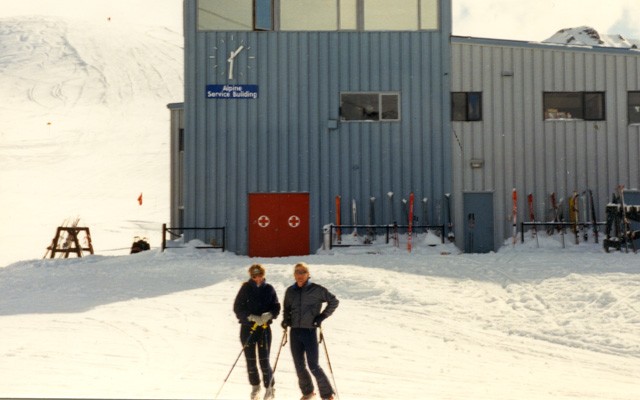
Everyday things could present a challenge — getting groceries for example. That was always an interesting affair. If we were shopping in the village, it would take four ski lifts to get them to the top of the mountain. If we had been shopping in Squamish everything was loaded onto the gondola in valley, and then off loaded at mid-station and reloaded onto the Red Chair. One of us would go ahead on the Red Chair, while the other loaded numerous milk crates (sorry Dairyland) full of our groceries — who ever got off at the top would unload the crates. Then we would ski them over to our apartment. I have to say, we never broke an egg.
In 1988 The World Cup downhill was cancelled due to the mid-mountain fog. Crazy Canuck Dave Murray was the Race Chairman. Although the race was cancelled, Rob Boyd ran the course, then went on to win the following year to become the first Canadian to win a World Cup downhill on Canadian soil.
Rob recalled, "Living at the base of the mountain certainly had its benefits. Probably the best use of the proximity was in '89 after my World Cup win, between finish line interviews and the podium ceremony I had a few days worth of scruff on my chin, and my mom insisted that I run home and shave before stepping up on the podium. So I did!"
Sandy and Molly have fond memories about Rob winning. For weeks Molly, Sandy, and the Whistler Singers had been practicing several national anthems for the podium presentation: in the end they sang O'Canada.
In the summer of 1988 the Express Lift was installed from the village to the alpine and our position was terminated: it was the end of an era. The mid-station position remained for another winter, Laird and Colleen returned to the valley in May 1989 and Sandy and Molly remained as the valley caretakers until 1992.
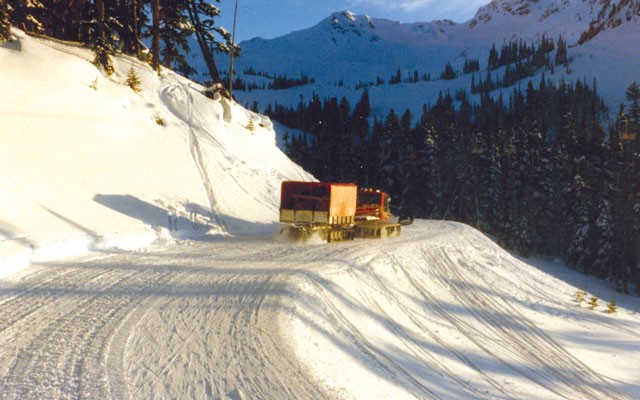
There are so many other memories I could write about... in the summer months shutting down Tower 18, hopping on my mountain bike and blazing down the mountain as fast I could to play baseball. On another summer's day a helicopter flew a grand piano up from Vancouver to place it on a stage built on Blackcomb Mountain to host the Vancouver Symphony Orchestra. It was quite the sight to see a piano hanging from a long cable.
Those were golden days, golden memories, and golden friendships.
I wish to dedicate this article to Laird Brown and Colleen Warner who were the best neighbours, and due to them we were able to remain connected to life in the valley.
And thanks to Whistler Mountain Ski Corporation, we lived and breathed mountain life, the spirit of the mountain was in our every cell and to all the dear friends — some of who aren't with us any longer — I feel it's safe to say it was amazing chapter in all our lives.

